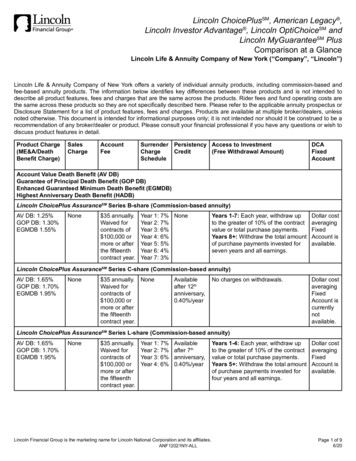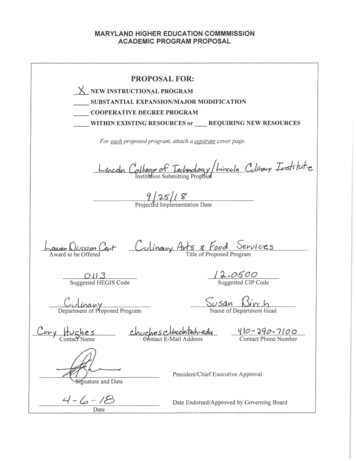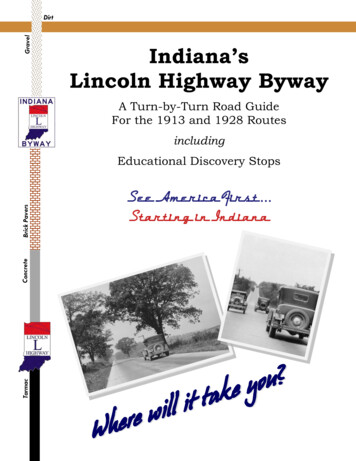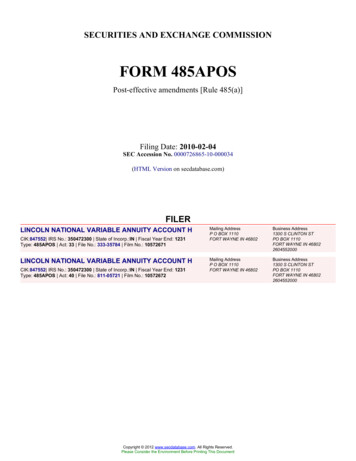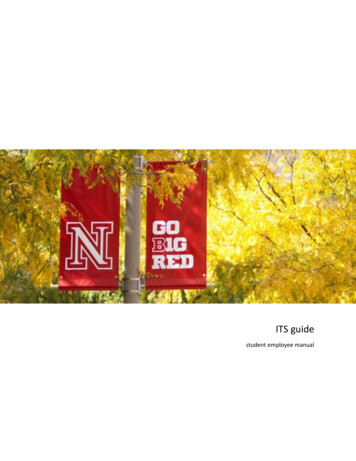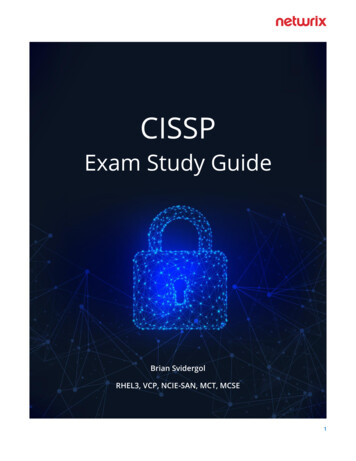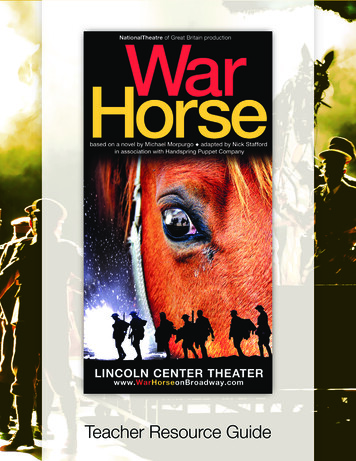
Transcription
Teacher Resource Guide
WH Title Page1.12.12 H4 title page.qxd 12/29/11 2:21 PM Page 1WarHorse:Teacher Resource Guideby Heather LesterLINCOLN CENTER THEATERAT THE VIVIANBEAUMONTunder the direction ofAndré Bishop and Bernard GerstenNATioNAL THEATRE of GREAT BRiTAiNunder the direction ofNicholas Hytner and Nick Starrin association withBob BoyettWar Horse LPpresentsNational Theatre of Great Britain productionbased on the novel by Michael Morpurgoadapted by Nick Staffordin association with Handspring Puppet Companywith (in alphabetical order)Stephen James Anthony Alyssa Bresnahan Lute Breuer Hunter CanningAnthony Cochrane Richard Crawford Sanjit De Silva Andrew Durand Joel Reuben GanzBen Graney Alex Hoeffler Leah Hofmann Ben Horner Brian Lee HuynhJeslyn Kelly Tessa Klein David Lansbury Tom Lee Jonathan Christopher MacMillanDavid Manis Jonathan David Martin Nat Mcintyre Andy Murray David PegramKate Pfaffl Jude Sandy Tommy Schrider Hannah Sloat Jack Spann Zach VillaElliot Villar Enrico D. Wey isaac Woofter Katrina Yaukey Madeleine Rose Yensets, costumes & drawingspuppet design, fabrication and directionRae Smithdirector of movement and horse movementmusicToby SedgwickAdrian Suttonassociate puppetry directorMervyn MillarNT technical producerKatrina Gilroymanaging directorAdam SiegellightingAdrian Kohler with Basil Jonesfor Handspring Puppet CompanyPaule Constableanimation & projection designsongmakersound59 ProductionsJohn TamsChristopher Shuttartistic associateproduction stage managerSamuel AdamsonNT producerChris Harperproduction managerJeff HamlinRick SteigerNT associate producerRobin Hawkesexecutive director ofdevelopment & planningNT marketingKarl Westworthdirector of marketingmusic directorGreg PliskacastingDaniel SweeBoyett Theatricals producerTim Levygeneral press agentHattie K. Jutagir Linda Mason Ross Philip Rinaldidirected byMarianne Elliott and Tom MorrisSponsorLeadership Support from The Jerome L. Greene foundation.Major Support from Ellen and Howard Katz in honor of Marianne Elliott,Florence and Robert Kaufman, The Blanche and Irving Laurie Foundation,and The National Endowment for the Arts.Official AirlineGenerous Support from Laura Pels International Foundation for Theater andThe Henry Nias Foundation courtesy of Dr. Stanley Edelman.National Theatre is supported by Arts Council England
Table of ContentsINTRODUCTION. . . . . . . . . . . . . . . . . . . . . . . . . . . . . . . . . . . . . . . . . . 1Synopsis of the Play. . . . . . . . . . . . . . . . . . . . . . . . . . . . . . . . . . . . 2Characters in the Play. . . . . . . . . . . . . . . . . . . . . . . . . . . . . . . . . . . 2THE BOOK AND THE AUTHOR. . . . . . . . . . . . . . . . . . . . . . . . . . . . . . . 4Michael Morpurgo's Biography. . . . . . . . . . . . . . . . . . . . . . . . . . . . 4Background on War Horse . . . . . . . . . . . . . . . . . . . . . . . . . . . . . . . 5Synopsis of the Novel. . . . . . . . . . . . . . . . . . . . . . . . . . . . . . . . . . . 5THE PRODUCTION. . . . . . . . . . . . . . . . . . . . . . . . . . . . . . . . . . . . . . . . 7Background. . . . . . . . . . . . . . . . . . . . . . . . . . . . . . . . . . . . . . . . . . . 7Development Process. . . . . . . . . . . . . . . . . . . . . . . . . . . . . . . . . . . 8Adaptation Challenges . . . . . . . . . . . . . . . . . . . . . . . . . . . . . . . . . . 8Production Elements. . . . . . . . . . . . . . . . . . . . . . . . . . . . . . . . . . . . 9THE PUPPETS IN WAR HORSE. . . . . . . . . . . . . . . . . . . . . . . . . . . . . . 11Making a Horse. . . . . . . . . . . . . . . . . . . . . . . . . . . . . . . . . . . . . . . 11Breathing Life into the Puppet. . . . . . . . . . . . . . . . . . . . . . . . . . . . 12WORLD WAR I . . . . . . . . . . . . . . . . . . . . . . . . . . . . . . . . . . . . . . . . . . 14Historical Overview. . . . . . . . . . . . . . . . . . . . . . . . . . . . . . . . . . . . 14Historical References in War Horse. . . . . . . . . . . . . . . . . . . . . . . . 15New Ways of War and Weaponry . . . . . . . . . . . . . . . . . . . . . . . . . 16The United States and New York City. . . . . . . . . . . . . . . . . . . . . . 17Timeline and Map . . . . . . . . . . . . . . . . . . . . . . . . . . . . . . . . . . . . . 19HORSES. . . . . . . . . . . . . . . . . . . . . . . . . . . . . . . . . . . . . . . . . . . . . . . 21Humans and Horses . . . . . . . . . . . . . . . . . . . . . . . . . . . . . . . . . . . 21Nature of Horses. . . . . . . . . . . . . . . . . . . . . . . . . . . . . . . . . . . . . . 21Horses on the Farm. . . . . . . . . . . . . . . . . . . . . . . . . . . . . . . . . . . . 22Horses on the Battlefield. . . . . . . . . . . . . . . . . . . . . . . . . . . . . . . . 22CLASSROOM ACTIVITIES. . . . . . . . . . . . . . . . . . . . . . . . . . . . . . . . . . 23BIBLIOGRAPHY . . . . . . . . . . . . . . . . . . . . . . . . . . . . . . . . . . . . . . . . . 30
IntroductionWelcome to the teacher resource guide for the U.S. premiere of War Horse the spectacular production fromLondon’s National Theatre in collaboration with South Africa’s Handspring Puppet Company. Based on Michael Morpurgo’s 1982 novel, War Horse tells the story of a deep bond between an English farm boy and hisremarkable horse and their separation at the outbreak of World War I. Each lands on the battlefield and mustsurvive the horrors of war in the hope of reuniting. The central character of this epic piece of theater is a lifesize horse puppet, an artistic and mechanical wonder, surrounded by an extraordinary cast of puppeteers,human actors and musicians. The original production was developed over nearly three years and opened atthe National Theatre in 2007 playing to sold out audiences and receiving wide critical claim before moving toLondon’s West End where it continues today. The U.S. premiere at Lincoln Center Theater has a new Americancast and the original creative team headed by co-directors Tom Morris and Marianne Elliott.War Horse offers many thematic and theater learning opportunities for students in areas related to: the novel War Horse and author Michael Morpurgo; the process of adapting the novel War Horse to the stage; the art form of puppetry; the history of World War I; and the horse and its essential role in human civilization.This document aims to provide background information related to the areas above and to be your guideto the resources that exist through books, video, and websites. We encourage you to photocopy and sharethe pages of this guide with your students. In each section, look for RESOURCES including links to materialsavailable online. At the end of the guide, you will find suggested classroom activities and ideas that you canimplement before or after seeing the production.Experiencing War Horse at Lincoln Center Theater will be an unforgettable experience for you and yourstudents. We hope the information provided in the guide supports you as you explore this production.RESOURCESFollow these links to access materials referenced in this guide and created by the National Theatre’s Discoverprogramme (NT):NT Resource Pack: WarHorse EduPack v1.pdfuNT Scheme of Work: WarHorse 08 Scheme of Work.pdfuWe suggest you use this resource guide in tandem with the NT’s publications as you develop your ownapproach to War Horse.WarHorse Teacher Resource GuideIntroductionPAGE 1
SYNOPSIS OF THE PLAYIn an English village, a drunk farmer buys a colt at auction. His young son Albert bonds with the colt, names itJoey and raises him. When World War I breaks out, the farmer sells Joey to the military to pay for his strugglingfarm. Albert is heartbroken. Major Nicholls, the officer who takes Joey, promises Albert that he will look afterhis beloved horse. Joey meets Topthorn, another army horse, and the two become a team. Soon after arrivingon the battlefields of France, Major Nicholls dies in battle, and the Germans capture Topthorn and Joey. Thehorses stay on a farm where Emilie a young French girl cares for them along with a kindly German soldiernamed Friedrich. Meanwhile, Albert joins the army and leaves for the war determined to find Joey. To avoidgoing into battle, Friedrich uses Topthorn and Joey to pull an ambulance wagon. Another German soldierforces the horses to pull an artillery gun and an exhausted Topthorn dies. Joey runs away and into “no man’sland,” the gap between the German and Allied trenches, where he is won by British soldiers in a coin toss.Severely injured, Joey is taken to the veterinarian at the army camp. Albert is at the same camp because hehas been temporarily blinded by poison gas during an attack. The vet decides that Joey is too injured to saveand must be killed, but moments before Joey is shot, he and Albert find one another. Albert vows to help Joeyrecover. As the war ends, the two return home to the farm together.CHARACTERS IN THE PLAY The HorsesJOEY, the colt sold at auctionJOEY, the grown stallionTOPTHORN, another army stallionThe FamilyTED NARRACOTT, the farmer who buys JoeyALBERT NARRACOTT, Ted’s son who raises JoeyROSE NARRACOTT, Albert’s motherARTHUR NARRACOTT, Albert’s uncle and Ted’s rivalBILLY NARRACOTT, Arthur’s son and Albert’s cousinThe VillagersSONG WOMAN/SONG MAN, a singer who leads the villagersin folk songsCHAPMAN CARTER, the auctioneer and later Sergeant CarterLIEUTENANT CHARLES NICHOLLS, later Major Nicholls,an officer who takes Joey to warA scene from WAR HORSE at the VivianBeaumont Theater. Photo: Paul Kolnik.WarHorse Teacher Resource GuideTHOMAS BONE and JOHN GRIEGIntroductionPAGE 2
British ArmySERGEANT ALLAN, an army recruiterCAPTAIN STEWART, friend of Major Nicholls who owns TopthornSERGEANT THUNDER, the officer who orients Albert to the armyDAVID TAYLOR, another younger soldier who Albert befriendsSERGEANT FINE, a commanding officer of David and AlbertTAFF, a soldier in the British trenches who saves Joey from “no man’s land”CALLAGHAN, a nurse at the British army campMARTIN, the army veterinarianGerman Army"Forward! Forward to victory." London:Parliamentary Recruiting Committee,1915. Source: The Library of CongressKLAUSEN, a soldier who captures Joey and Topthorn and later forcesthem to pull a gunFRIEDRICH MULLER, a kindly soldier who looks after Joey and TopthornCOLONEL STRAUSS and DR. SCHWEYK, officers who demand thatJoey and Topthorn pull an ambulanceSERGEANT KLEBB, an officer that Friedrich lies toMANFRED and LUDWIG, soldiers in the German trenches who findJoey in “no man’s land”French CiviliansEMILIE, a young girlPAULETTE, her mother"The horse is man's noblestcompanion." Horst Schreck, 1920.Source: The Library of CongressRESOURCESNT Resource Pack: WarHorse EduPack v1.pdfFind a detailed play synopsis on pages 3 to 5.uNT Scheme of Work: War Horse 08 Scheme of Work.pdfFind a detailed play synopsis on pages 5 & 6.uWebsite: War Horse on Broadway www.warhorseonbroadway.com/Website: War Horse London warhorselondon.nationaltheatre.org.uk/uuScript: Stafford, Nick. War Horse, based on the novel by Michael Morpurgo. Faber and Faber. 2007.WarHorse Teacher Resource GuideIntroductionPAGE 3
The Book & the Authorhe very best children’s books are extraordinary“ Tstoriesand appeal to everyone, children andadults alike.”Michael Morpurgo, Making War Horse, DVDMICHAEL MORPURGOMichael Morpurgo is a much admired and successful British authorof more than one hundred books written for young people. Hiswork, which includes historical fiction, animal stories, fantasy novels, picture books, easy readers, and retellings of legends and myths,has garnered major awards and worldwide popularity. Many of hisbooks have been adapted to stage and screen including the filmWhy the Whales Came starring Helen Mirren. The latest adaptation will be an upcoming film version of War Horse directed bySteven Spielberg. Mr. Morpurgo’s storytelling is magical in style andoften deals with issues that affect the lives of children. He drawsfrom his own experiences and interests to create his stories thatgrapple with themes like the triumph of an outsider, survival againstthe odds, abandonment and rescue, and relationships with animalsand nature.Mr. Morpurgo lives in a small village in southern England and spendshis time writing, working on his farm, and speaking to young people. While a classroom teacher in his early career, he discovered his Michael Morpurgo. Photo: Richard Cannon.knack and love for storytelling for children. In 1976, he left teachingand with his wife started Farms for City Children that brings young people who live in urban areas to live onrural farms each summer. In 2003, Michael Morpurgo became England’s Children’s Laureate that recognizesa lifetime contribution to children’s literature and highlights the importance of the role of children’s books.For more information on the author and his other novels, visit www.michaelmorpurgo.com. Learn more aboutFarms for City Children at www.farms4citychildren.co.uk.Other books by Michael Morpurgo: Amazing Story of Adolphus Tips, Shadow, Private Peaceful, Kensuke’sKingdom, The Dancing Bear, and Alone on the Wide, Wide Sea.WarHorse Teacher Resource GuideThe Book & the AuthorPAGE 4
BACKGROUND ON WAR HORSE“ When I wrote War Horse, I was very interested in writing a story which somehowexpressed the universal suffering that went on in war.Michael Morpurgo, The Horse’s Mouth”War Horse has been popular among young readers since it was first published in 1982. Michael Morpurgo was inspired to write War Horse by apainting that his father-in-law gave to his wife depicting a horse cavalrycharging up a hill toward German troops and the horses being felled bybarbed wire. He learned that between one and two million horses hadbeen killed in the World War I, a figure he found shocking. He also had a casual conversation at the local pub with a World War I veteran who recounted his struggles as a young man forced to leave his small village to fight aterrible war in northern France. Like most British, Mr. Morpurgo’s family wasaffected by the war. An uncle died a young war hero while another became a pacifist. Mr. Morpurgo set outto write a book that did not tell a one-sided account of World War I. He wanted to offer different viewpointsto emphasize the common misery caused by war so he decided to tell the story from the point of view of ahorse from a small English village sent to the battlefields of France.MAJOR THEMES: War Horse touches on many themes including love, loyalty, the human-animal bond, loss,grief, anger, pain, bravery, desire for revenge, the uselessness of war, separation, excitement, survival and identity,leaving a small town to fight in another country, and universal suffering.SYNOPSIS OF THE NOVELJoey is a beautiful thoroughbred horse whose earliest memory is of being sold at auction to a drunk farmer.He is lucky enough to meet the farmer’s son, Albert, who raises Joey lovingly. Albert even trains Joey to plow,a seemingly impossible task, to win a foolish bet made by his father. War breaks out. Desperate for money, Albert’s father sells Joey to the army. Joey is taken away from Albert. He meets Topthorn, another military horse,and the two become friends. Once on the battlefield in France, the horses lead a cavalry charge into enemymachine gun fire and many soldiers die. Joey and Topthorn are taken to a farm where they meet a youngFrench girl named Emilie who takes care of them. Joey and Topthorn are forced to pull a heavy artillery gun,and Topthorn collapses and dies. Distraught, Joey runs off and into “no man’s land,” the expanse between enemy lines. Saved by a British soldier, he reunites with Albert who has become a soldier. But, Joey’s life is stillin danger. He must recover from tetanus and is destined to be sold to a butcher. Emilie’s grandfather steps into buy Joey. Emilie has died, but her grandfather promised her that he would find Joey whom she loved andbring him home to the farm. When he sees how much Albert loves Joey, he sells the horse to him for a pennyand a promise that Albert will care for Joey for the rest of his life.WarHorse Teacher Resource GuideThe Book & the AuthorPAGE 5
RESOURCESNT Scheme of Work:War Horse 08 Scheme of Work.pdfFind a detailed synopsis on pages 3 and 4.uFind lessons that explore the writer’s inspiration and family legends on page 7.Online Essay: Mopurgo, Michael. Adapt and Survive. Michael Morpurgo talks about adaptations of hisbooks. The Guardian. August 21, l-morpurgo-on-stage-adaptations uDVD: “Extended Interview with Michael Morpurgo.” Making War Horse. Directed by Phil Grabsky andDavid Bickerstaff. DVD. National Theatre/Seventh Art Productions. 2009.Book: Morpurgo, Michael. War Horse. Scholastic, 2010.Find teaching resources and information about the book at http://www2.scholastic.com/browse/book.jsp?id 4602Book: Carey, Joanna. Telling Tales: An Interview with Michael Morpurgo. Mammoth. 1999.Book: Fox, Geoff. Dear Mr. Morpingo: Inside the World of Michael Morpurgo. Wizard Books. 2004.WarHorse Teacher Resource GuideThe Book & the AuthorPAGE 6
The ProductionBACKGROUNDThe journey of War Horse began in 2004 as director Tom Morriswas searching for new projects to develop for London’s NationalTheatre in his role there as an associate director. He was especiallyinterested in collaborating with Handspring Puppet Company fromSouth Africa whose outstanding work he had come to know whilethe Director of Battersea Arts Centre in London. Mr. Morris poredover possible materials when his mother suggested Michael Morpurgo’s War Horse. He immediately recognized the potential forWar Horse to be translated to the expansive stage of the National’sOlivier Theatre with a Handspring puppet as the central characterof a horse. From there, he began a nearly three year process to bringthe project to life.Tom Morris.THE NATIONAL THEATRE (NT)www.nationaltheatre.org.uk is a world renowned producing theatercompany in London, England. At its theater complex on the banksof the Thames River, the NT presents more than twenty stage productions in its three theaters each year, a mix of classic, contemporary and new works, often with seven or eight in repertory at onetime. Started in 1963, the NT is supported in part by the British government and was officially named “Royal National Theatre” in 1988.The NT has a special commitment to nurturing new work and hasrecently begun producing theater for young audiences making it aperfect match for the War Horse project.HANDSPRING PUPPET COMPANY (Handspring)www.handspringpuppet.co.za is based in Cape Town, South Africaand was founded in 1981. Two of the co-founders, Adrian Kohlerand Basil Jones, continue to run the company. Originally they created shows for children and thereafter works for adult audiences.Arguably one of the greatest puppetry companies in the world,Handspring has collaborated with innovative South African directors and presented at international festivals around the world. Thecompany provides an artistic home and professional base for a coregroup of performers, designers, theatre artists and technicians whocollaborate with them on a project basis. They continue to exploreWarHorse Teacher Resource GuideThe ProductionAdrian Kohler and Basil Jones. Photo: Pieter Hugo.PAGE 7
the boundaries of adult puppet theater within an African context. In the National Theatre’s video documentaryMaking War Horse, Adrian Kohler explained why he was attracted to the project,“The thing that intrigued memost [about War Horse was] seeing war through the eyes of an animal. The neutrality of [the horse], the waythat it didn’t make judgments about any situation, was what appealed to me. Plus, the love story of the boy finding his horse again. That I knew was a winner.”DEVELOPMENT PROCESSTransforming War Horse from a popular novel told from a horse’s viewpoint to a theatrical script and thena three-dimensional stage production with dozens of actors and starring life-size puppets required imagination, thought and time. Tom Morris knew the place to begin would be the National Theatre Studio, a programwithin the NT that provides artists with space to explore potential projects and experiment with ideas withoutthe pressure of expected outcomes. This freedom allows artists to take risks and discover whether a theatricalidea is feasible early in the development process.JANUARY 2005: The War Horse project began with aweek-long workshop at the NT Studio. Tom Morris alongwith Handspring artists Adrian Kohler and BasilJones worked with a small group of actors to explorethe dramatic potential of the novel and to experimentwith simple puppetry. In the months following the workshop, they continued to develop their ideas and newmembers joined the team. Marianne Elliott becameco-director along with Tom Morris. Her experienceMarianne Elliott. Photo: Kevin Cummins.working with actors and her focus on text and detailedpreparation balanced Mr. Morris’ improvisational andphysical approach. While somewhat unusual to have two directors, the show’s scale and scope required it.Nick Stafford was commissioned to write the stage adaptation of the novel. An accomplished dramatist, herevised and refined the script through the final stage of rehearsals. Rae Smith became the production designer in charge of developing the overall design concept. She also designed the sets and costumes.ADAPTATION CHALLENGES“ There was no question ever of the horse speaking. So, that was a challenge.thenecessity of finding a story which put the horse at its center but which denied thehorse a speaking voice.”Nicholas Hytner, Director of the National Theatre, Making War Horse, DVDStage adaptations of literary works are common, but War Horse presented a set of unique theatrical challenges for dramatist Nick Stafford. His first hurdle was shifting the point of view from first to third person.In the novel, the story is told by Joey as internal thoughts. In the play, the horse is silent and the plot unfoldsWarHorse Teacher Resource GuideThe ProductionPAGE 8
without a narrator. Mr. Stafford’s dialogue includes narrative that the novel delivers through Joey’s observations. Next, Mr. Stafford found ways to maintain the story’s objective view of war. In the novel, war is presentedas equally bad for all. Joey judges people by their actions not by their nationalities. Mr. Stafford’s scenes focus on the personal not the political aspects of war. The play’s characters are multi-dimensional individualswhose attitudes and behaviors transcend national stereotype. Follow this link to the NT Scheme of Work andvisit pages 10 to 13 to read about specific dramatic devices that Nick Stafford uses in the stage adaptation.War Horse 08 Scheme of Work.pdfNOVEMBER 2006: The project returned to the NT Studio for a second workshop with writer Nick Stafford’sdraft script and a horse puppet prototype built by Handspring’s Adrian Kohler. Led by Ms. Elliott and Mr.Morris, the actors explored the script and Mr. Stafford revised it. They experimented with the dynamics ofthe horse puppet prototype which involved three puppeteers. Mr. Stafford had aligned the story with a fiveact narrative structure, so as they workshopped the script, the co-directors looked for symbols and storyelements that could support the narrative. With the actors’ input, Mr. Stafford expanded characters so theyexisted beyond the horse’s narrow view in the novel. This meant adding new characters like Sergeant Thunder and removing others. Watching the actors, designer Rae Smith imagined ways to sustain dramatic visualimages through the story. Members of the expanded design team attended the workshop to develop theirideas. The co-directors explored practical issues of how to stage transitions as well as more complex sceneslike the channel crossing and cavalry charge. The workshop was helpful in solving problems and moving theproject to the next stage. Following the intensive second workshop, the team continued to refine the vision,script and design.PRODUCTION ELEMENTSThe designs for the set, lighting, sound, music, and costumes began to emerge and centered on two separateworlds inhabited by the characters: the Devon village where the story begins and the battlefields of war.The designers aimed to achieve a broad cinematic scope that would support the epic tale and unconventional central character and would fill the vast stage of the Olivier Theatre.DESIGNER RAE SMITH drew inspiration for the stage environment from the expressionist art movement ofthe early twentieth century with stark visual images that reflected themes of World War I. Her set is minimalto allow the actors and puppets ample room for movement. Places are created with props and moveable setpieces. The fence held by the actors in the first scene mimics puppet rods. The character of Major Nichollscarries a sketchbook that inspired Ms. Smith to generate hand-drawn landscapes projected onto a backdrop.The torn swathe that is the backdrop emerged when Ms. Smith ripped a page from the sketchbook and installed it in the set design.LIGHTING DESIGNER PAULE CONSTABLE created two distinct lighting schemes to depict the differentlocales. In the rural community of Devon, the lighting comes from high angles. It is warm, beautiful sunlightmeant to evoke a secure, happy, natural place. When the action moves to the battlefield, the lighting comesfrom very low angles and is harsh, colorless, and full of shadows.The effect makes the war zone seem unnatural, disturbing and unsafe.WarHorse Teacher Resource GuideThe ProductionPAGE 9
SONGMAKER JOHN TAMS integrated traditional English folk songs into scenes to convey the spirit of thevillage community that goes to war. The character “Song Man” was added to weave folk songs that expressemotion and situation throughout the play.MUSIC COMPOSER ADRIAN SUTTON created powerful melodies as a counterpoint to the action onstage.A full orchestra of sound provides emotional atmosphere. Instrumental elements and musical sequences support the story and themes.SOUND DESIGNER CHRISTOPHER SHUTT complemented the visual landscape with a soundscape thatcommunicated place and time. When the stage is awash in the pastoral setting of rural England, Mr. Shutt fillsthe stage with birdsong and other sounds. In the scenes of war, his eerie sounds of explosions and gunshotelicit terror.MARCH 2007: The third workshop at the NT Lab involved staging the newest draft and further developing theproduction elements as the team moved toward a full production.AUGUST 2007: The creative team, a cast of thirty actors, puppeteers and musicians and a full technical crewbegan seven weeks of rehearsals.OCTOBER 2007: War Horse opens at the NT's Olivier Theatre.MARCH 2009: War Horse begins an open ended run at the New London Theatre in London’s West End.JANUARY 2010: Rehearsals begin for the U.S. premiere with an American cast of actors and puppeteers atLincoln Center Theater co-directed by Tom Morris & Marianne Elliott. Follow this link to read about the rehearsal process for the American premiere on the LCT show blog: www.lct.org/showBlog.htm?id 199.RESOURCESNT Resource Pack: WarHorse EduPack v1.pdfuFind further background on the production process in “Putting the Production Together” on page 6 to 10.NT Scheme of Work: War Horse 08 Scheme of Work.pdfuFind lessons on adaptation on pages 10 to 15, design renderings on page 28 to 30, and photographs of the lighting on page 31.Online Video: se.html“Play Now: National Theatre Documentary on War Horse.”uBook: Millar, Mervyn. The Horse’s Mouth: Staging Morpurgo’s War Horse. Oberon Books. 2008.DVD: Making War Horse. Directed by Phil Grabsky and David Bickerstaff. DVD.National Theatre/Seventh Art Productions. 2009.Website: www.raesmith.co.uk/selected warhorse.html“War Horse designs by Rae Smith.” Raesmith.com.WarHorse Teacher Resource GuideThe ProductionuPAGE 10
The Puppets in War HorseA major challenge in adapting the novel to the stage was whether the audience would accept a puppet as thecentral character of Joey. In the documentary Making War Horse, puppeteer Finn Caldwell described howthe theatrical convention of puppetry engaged audiences,“When you come out onstage with some wood thatis made into a shape, you are implying to the audience ‘I’m going to play a game with you. Do you want toplay along?’ If the audience stays and they watch, then they are agreeing to play this game. It is like playingwith toys. I think it invites adults to be open, like a child. I think that is why they have such a strong emotionalreaction to the show.”Seth Numrich (center) and company in a scene from War Horse at the Vivian Beaumont Theater. Photo: Paul Kolnik.MAKING A HORSEThe design for the puppet of Joey evolved early in the production’s development. In the first workshop at theNT Studio in January 2005, Basil Jones and Adrian Kohler gave the actors masks and simple costume piecesto experiment with ways to portray a horse onstage. For the
WarHorse Teacher Resource Guide THE BOOk & THE AUTHOR PAGE 5 BACKGROUND ON WAR HORSE “ When I wrote War Horse, I was very interested in writing a story which somehow expressed the universal suffering that went on in war .” Michael Morpurgo, The Horse’s Mouth War Horse has been popular a
